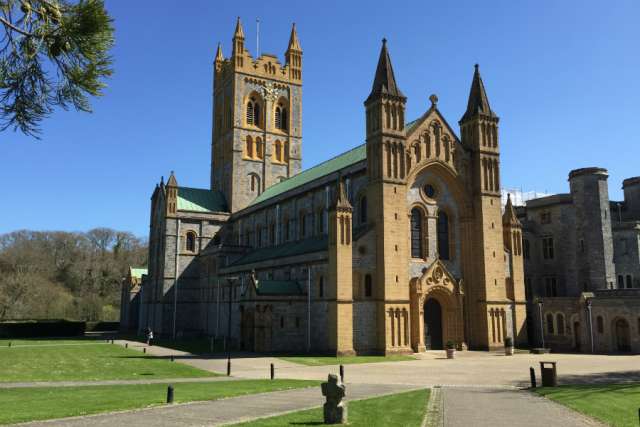England's Buckfast Abbey to celebrate 1,000 years of foundation
In 2018, one of England’s historic monasteries will celebrate the millennium year of its foundation, offering a prime example of the contribution of m
Oct 27, 2017

By Elise Harris
In 2018, one of England’s historic monasteries will celebrate the millennium year of its foundation, offering a prime example of the contribution of monastic life to society amid an increasingly fast-paced world.
For the Benedictine monks who inhabit Buckfast Abbey in Devon, reaching such a significant anniversary means “we are the inheritors of a great tradition,” said Abbot David Charlesworth.
“Place matters for Benedictines, so the fact that we are in a place that has been established for many centuries before we came is important.”
Not only do Benedictine monks take the traditional vows of poverty, chastity, and obedience, they also make an additional vow of stability, meaning that, when they are assigned to a monastery, they stay there. While they might travel or even spend time in other monasteries, they will always be attached to the original, as an individual would be to their family home.
Charlesworth, who served as Abbot at Buckfast from 1992-1999, and was re-elected in 2009, said that in general, human beings “like the idea of roots.”
The concept of monasticism is ultimately rooted in the Gospel and expressed through the Rule of St Benedict, he said, but it is also rooted “in place, in a place, and it is from there, out of that place, that we then live our Baptismal vocation expressed through our monastic vocation.”
When it comes to living this vocation in modern times, the millennium landmark “helps to sort of galvanise our approach as to what we’re doing for the future,” Charlesworth said. This, he added, encompasses “what we’re doing personally, what we’re doing as a community, and what we're doing as members of the Church of the Southwest of England.”
The abbot spoke about the millennium anniversary during a sit-down interview inside one of the two main guest houses at Buckfast Abbey, located in Buckfastleigh, about 25 miles northeast of Plymouth.
The abbey was founded in 1018, during the reign of King Cnut, and entrusted to the care of the Benedictines.
The monks who inhabited the monastery followed the Regularis Concordia rule, which was drafted in Winchester around the year 970 for all Benedictine monasteries in an effort to re-establish, in a sense, monastic life.
Just over 100 years later, in 1147, Buckfast became a Cistercian monastery. The Order was founded in 1098 by a group of monks seeking to live a simpler life in more strict observance of the Benedictine Rule.
Under the Cistercians, Buckfast thrived, exporting wool to Italy by the 14th century. By the 15th century, the monastery had, in essence, become a wealthy landowner, while continuing to run an almshouse and school, and supporting local parishes in the area.
But in 1539, it was shut down by the commissioners of King Henry VIII during the dissolution of the monasteries in a bid to confiscate the wealth of the country’s religious institutes during the English Reformation.
The monastery was immediately vacated, stripped and left to decay. During the more than 300 years that Buckfast was without monks, the monastery changed hands four times, eventually landing in those of Dr. James Gale in 1872, who decided to sell the property, but wanted it to go back to a reli-gious community.
Just six weeks after putting an advertisement in the paper, Buckfast was purchased by monks, who moved in shortly after, bringing a close to the 343 year gap in monastic presence at the abbey.
That first group of monks who returned to Buckfast were Benedictines who had been exiled from France and had made their way to Ireland. They moved to Buckfast in 1882 after acquiring the abbey, and began the process of restoring the property.
As the work was being carried out, the ruins to the original Cistercian design from the 1100s were discovered, and the monastery was constructed in its modern form from the ancient layout. The abbey was consecrated in 1932, with the final stone of the large bell tower being laid in 1937.
Now in 2017, the monastery is again a thriving presence in Devon. Not only does Buckfast represent a silent spiritual hub for tourists or visitors who want to get away for a day of prayer, but it also boasts of several other major activities available for people throughout the area. The Buckfast monks essentially serve as the board of trustees for the St Mary’s grade school that sits on their property, and the abbey hosts a centre for evangelizsation called the School of the Annunciation, which was established as a response to the Church’s call for a new evangelisation.
The school offers formation to adults from all walks of life, and it also holds the status of a Catholic Institute for Higher Learning, providing distance-learning opportunities for students to obtain Master’s Degrees in Catechesis and Evangelisation, validated by the Franciscan University of Steubenville, Ohio.
Buckfast also has a large conference centre where they host various congresses and retreats throughout the year, including for non-Catholic groups. The monastery also offers two refurbished guest houses for pilgrims and tourists. They also have private houses available for rent if people want a longer get-away. Buckfast also has a cafeteria and an adoration chapel open to visitors. Monks also offer pilgrims the opportunity to pray Vespers with them every evening. --CNA







Total Comments:0